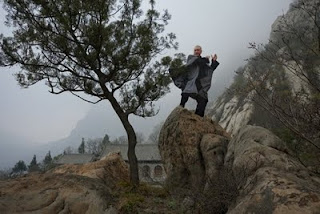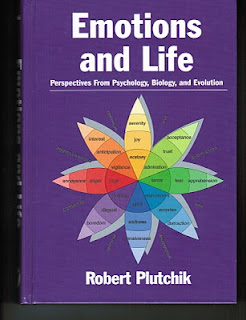Notes from my January 2006 Zhan Zhuang Training Journal. I train with The School of Cultivation and Practice which practices Wujifa zhan zhuang.
(My current reflections are added in italics.)
* As I begin 2006, I am doing stance for one hour a day. My mind wanders and so the quality of my practice time needs improving. My Wujifa instructor speaks of feeling "fascial stretch". I don't feel that yet.
* Question: How can I get my mind to stay focused on my body during stance?
Answer: First, before you practice, prepare. Spend a minute telling yourself that whatever there is to think about, you have either already thought about it or you will think about it later. In every case, you will probably not have an original thought that you will remember by the end of the hour. Therefore, thinking is useless and a mere distraction. Second, tell yourself that you are there to practice for that one hour and program yourself to ignore, to just let pass by, any thoughts that arise.
(Another trick I've mentioned elsewhere is to convince yourself and realize that for this period of time, there is nothing to do but relax. Another trick, if you have thoughts of stuff to do, is to do a few things before practice so then you've fulfilled that desire and can now relax...)
* The doorway stretch; an exercise to open or stretch the chest/heart area. Stand feet parallel facing a doorway threshold. Extend arms horizontally straight out from shoulders across a doorway frame and allow your torso to lean in to and through the doorway opening. Not the same as doing "flies" on the weight bench. Allow gravity to do the work. Don't pinch the back. Roll the shoulders back and down. Lift the chest and open, extend, expand.
* Squats. Do 100 a day with the intention on relaxing and opening the lower back. Feet parallel about half a foot length apart. Toes point slightly inward. Keep back straight. Drop into full squat. Relax at bottom. Let lower back stretch. When going up, push with heels. Keep back straight. No leaning. Head held as if with books on top. Squats work the kidneys. Kidneys hold fear, so as you open the lower back and the kidney area, fears will be brought up.
(When I first practiced squats this way, I identified a bunch of muscle imbalances in my body. I still can't do these as described here. I'm still working on resolving my chronic tensions and imbalances. I don't know if I'll ever get all the twist and tension out of my structure.)
* Question: How do I know if I'm doing stance right? How can I self-validate in the absence of a teacher?
Answer: If you do not feel the weight in your legs, then you're cheating. One way to check is to shift all the way back onto your heels so you are teetering on the edge of falling backward off your heels. When you are just this side of losing balance, then sink into the legs. Shift the weight forward slightly by moving the knees forward while sit back and down closing the kua.
(Don't assume that you'll get this right just from reading the above. I have been coached on this deceptively simple maneuver repeatedly throughout the years and while I need fewer course adjustments, I still need guidance with the micro-adjustments. I still can't do it right by myself.)
* Look for the "Structure of Magic" books by Bandler and Grinder:
(What does language and communication have to do with zhan zhuang? In Wujifa class we learn to listen for the more subtle levels of the emotional "charge" behind the spoken words which reveals what also shows up in the body's muscular holding patterns; everything is connected. Remember, what you haven't noticed is subtle until you notice it and then it becomes obvious.)
* We listened to a lecture about compressing and expanding time through various awareness exercises. One for example, the drumming exercise, 1,2,3,4. L,R,L,R. Listen for the space between beats. Keep the beat in your head and practice being aware of what's happening between beats. Then move into your body. Listen and feel the space between heart beats.
* We got "scolded" for relying on being spoon fed methods and we need to stop doing that.
* Do core stretches to release tensions, for example: first level: "Eight Pieces of Brocade" and second level: "Five Tibetans (Five Rites)". Be mindful of maintaining the feeling of connection, fascial stretch throughout body.
* Have an inquisitive mind. Practice. Observe. Present findings. Based on responses... Refine practice. Repeat.
* Stance is a method to unwind the body. It is a standing meditation. To "unwind" means to relax and release the muscular tensions. Like peeling an onion. As one layer is released/relaxed, a new layer of tension at a deeper level is observed. When standing, don't be a dead post. Don't be rigid. Seek movement in stillness.
* When you stand relaxed, your body will naturally sway forward as you breath in and backward as you breath out. This is an indication that you have reached one level of relaxation. The next level is to continue that movement under the skin. This means to stand still so that to an observer, you would appear to not be swaying. But in fact, in order to be still outside, there must be a lot of inner adjustments taking place to continue the natural forward and backward swaying.
(I just came back to this in my current practice. This time though, I got a really nice suggestion in class on how to play this a bit differently to take my practice to another level.)
However, before you get to this level, you must get past the beginner "stance dance" level and you must have gotten your mind to calm down to be able to devote 100% of your feeling attention without distracting thoughts to your inner body.
* To move from "stance dance" to stillness, check 1,2,3,4 then two breaths, then check 1,2,3,4 then two breaths, etc... Eventually increase from two to four breaths then to ten, twenty, etc.. up to 100 breaths. Eventually find your 100 breaths in an hour stance. Then slow your breathing and still do 100 breathes.
(Keeping the little monkey mind focused long enough to count 100 breaths is an exercise in itself. When you achieve this, what else do you notice?)
* Question: What does this Koan mean: "What is the face of your grandfather before you were born?"
Answer: After you've gone through releasing chronic muscular tension (armor), then you will know. Armoring is handed down through the generations. All armor is in place by the time you are ten years old. So all work to find these "treasures" involves finding and identifying and releasing your grandfather's face before you were born.
* The Tomato Plant Story (A Training Analogy)
- If you water the tomato plant everyday, the roots don't grow very deep so if you forget to water one day, then the plant withers.
- If you water in a circle a few inches from the plant, then the roots, searching for water, reach out to the water, growing.
- If you water a lot every few days, then the roots will reach deep to find water.
In case 2 and 3, you are stressing the plant and in so doing a creating a healthier plant. So, stress is good. Pain is good but you must be able to distinguish good pain from bad pain.
* Question: Can I practice the exercises that you tell others to practice?
Answer: Only take your own medicine. Eating someone else' medicine will either do nothing for you (except disillusion you to the effectiveness of the medicine) or will hurt you because you're not ready for that medicine yet. The wisdom is knowing that you don't need someone else' medicine.
Further reading:
Introductory article explaining this "Journal Notes" series:
Zhan Zhuang Training Journal
Previous article in this series:
Training Spirit (神;shén): Journal Notes #34
Next article in this series:
Walls, Heads and Hearts: Journal Notes #36



